Interlux Pacifica Plus, the seven month test
Antifouling bottom paint is a tricky subject, especially now that we’re rightfully paying more attention to the health of the waters it works in and the health of the people who apply it. So I was happy to experiment with copper-free Interlux Pacifica Plus this season, and the results were better than this photo looks. In fact, I may well use it again next year, but I would like to understand more about what chemistry actually constitutes a safe and effective bottom paint…
First I should explain that Gizmo’s home port of Camden Harbor is also home to a particularly aggressive brown slime. It may be because the Megunticook River foams into the head of the harbor as a waterfall, or that the output of the town’s sewage treatment plant is piped into the same area, or a combination of the two. I gather that many harbors are distinct micro climates in terms of boat-bottom-loving flora and fauna, and also that fouling conditions can change yearly due to variable biology and water temperatures (and of course they change from region to region, and further vary with how a boat is used). So meaningful comparisons of bottom paint, even using the same boat in the same place, are tough!
Nonetheless, I’d say that Pacifica Plus did at least as good a job as the Interlux Micron CSC I used in 2010, though the pictures below — both taken during mid-December haulouts a year apart — need explanation…
For one thing, I never touched the blue Pacifica Plus paint job (except for brushing around the underwater lights) while I got so upset with how the slime looked on the green Micron CSC that I put on a wet suit and scrubbed the whole waterline in August, 2010. So what you see above is seven months growth while some of what you see below only represents about four months. It’s also hard to see how much scuzzier the lower, shaded, and definitely un-brushed portions of the CSC bottom are. Note too how the slime on the Pacifica Plus was coming off with just a light finger touch in the opening photo; I’m quite sure that it would have been easier to brush clean in the water than the CSC was, and thus could have looked better by season end. And, incidentally, it costs less than CSC.
So I’m pretty happy with Pacifica Plus, but am I really doing the environment a favor by going copper-free? This Practical Sailor piece suggests that’s so, and also that California may soon ban copper-based antifouling paint altogether. And certainly ePaint makes favorable claims for its biocide chemistry versus traditional copper. But I notice that Interlux makes no particular “green” claims for Pacifica Plus, only that it’s “designed for those looking for copper-free antifouling.” And the yard manager at Wayfarer told me that while this paint is safer for his employees, he’s not convinced that it’s better for the harbor. He also said that the DEP hasn’t approved any bottom paint yet. Anyone know what’s going on here?
One guy who might have some valuable input is Interlux Technical Sales Rep Tim Taylor, who set up this bottom paint comparison. He also advised me about painting that bit of polyethylene spray rail that passes through the boot stripe and used to look awful when the slime got to it. I was especially dubious because that rail gets flexed substantially by the travel lift straps, but his advice — simply scuff the rail and spray on an AwlGrip topcoat — worked very well.
In fact, during this last haulout strap strain actually broke the (cold) spray rail, but the AwlGrip didn’t chip or peel a bit! I’m hoping that a glue repair is possible, and also thinking that we should try moving the “strap here” labels on Gizmo further aft. Is there ever an end to a boat owner’s problem solving challenges?


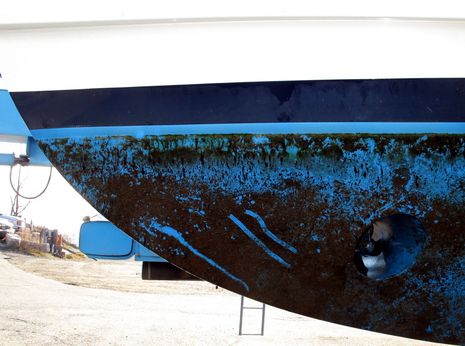

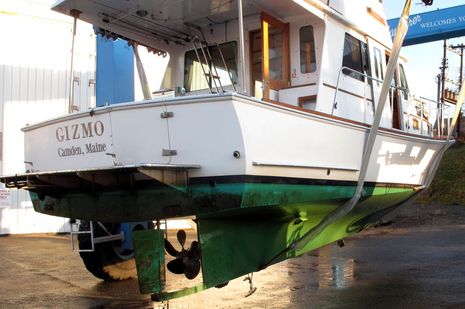
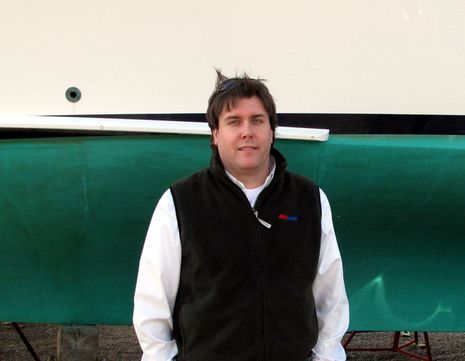
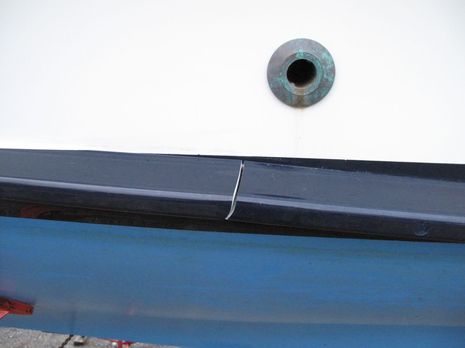
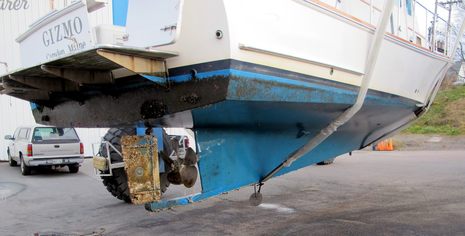

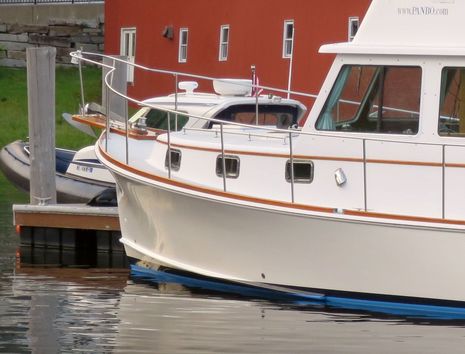








Ben,
I am pleased to hear your initial comments on these two paints. I am preparing to haul out the Valkyrie to replace a wonderful ablative paint for a copper free paint. My current choice is called BottomSpeed and is made by the company that makes PropSpeed.
If it does not work as well as the ablative, it will be a costly mistake, but since here in CA we are trying to ban copper (not yet), I am willing to try a bit of “green” to see how well it works out.
I would love to hear any feedback besides your two tests from others. By the way, my currnet paint has gone 3 years and still looks good. If I can get close to this I will be thrilled.
Do you have any other reports on copper free paint?
Yes, for those who are watching, I did take down some comments. Let’s talk about paint, not some silly old crap about a boat yard.
You’re opening up a can of worms here (more like a bucket of barnacles). The online threads addressing this topic are endless. “The Environment” is a big place. On a parts-per-million basis, how much good these new paints are doing for the environment beyond the marina is questionable (especially if what I’ve heard is true… that commercial vessels are still using the good poison). Policies that prohibit dockside scrubbing, for example, only serve to push that activity to secluded anchorages where we definitely don’t want the impact. Frankly, I’m less concerned about the health of barnacles and muscles in marinas, where boats spend most of their lives and where most of the “impact” is to be had. That’s a trade off I can live with. As for the new paints, I suspect the greater good is being served where the product meets human tissue, in the boatyard and later when scrubbed by a diver. Our boat is steel with a flame-spray aluminum coating, so we use bottom paint suited to aluminum hulls (which use very little if any copper and formerly used tributyl tin as the toxic agent). The old tin-laden Interlux Micron 33 was fan-tastic antifouling (but I’m not a fan of diving in a cloud of it). Its replacement, Trilux 33, is less effective, however it is passable with the right mil thickness and periodic scrubs (I’m sticking with it). To its credit, it has adhered flawlessly to the old product (w/ a Primacon tie-coat), for which I am greatly thankful (not a single bonding failure anywhere in five years). Afterthought: PropSpeed on the prop and shaft has held up superbly for the better part of three years. I love that slippery stuff. Have wondered whether it could scale to an entire hull. Will be curious to see how BottomSpeed pans out.
I plan to use Pacifica Plus on my prop next year. While Interlux still recommends an epoxy base be applied to props before adding an active coat, the lack of metal in Pacifica allows it to be applied directly to the prop. I will also paint part of my hull with Pacifica Plus to compare performance with the excellent (for me, in the upper Chesapeake) Bottomkote ACT. Interlux reps told me to expect similar performance.
Jon
Ah, the joys of being on a huge inland lake with perpetually cold water…
Weren’t the tin-based biocides the only ones that actually worked, and aren’t internationally-flagged vessels still using them, and only recoating every five years? Or, should I check this in snopes.com?
If you still have Interlux’s ear, I’d be curious if they have any plans to promote Intersleek more in the near future. I think the recreational product is Intersleek 970 but trying to find anyone that has any experience with it whether owner or boatyard is difficult if not impossible.
Understanding the speed and amount of underway time of commercial vessels is not a fair comparison to recreational power and even more so with sail, the results are still encouraging. Currently it seems Intersleek is a niche product at best but I would think in time it could benefit consumers and the environment more than any other chemical concoction.
For a nice visual graphic on why it is important to worry about “the environment” and how it is not such a big place, go here:
http://www.sciencephoto.com/media/159214/enlarge
The small blue drop next to the globe is the amount of water on earth, compared to the size of the earth. It is pretty shocking, but accurate. Although much of the earth’s surface is covered by water, in most places the water is not that deep.
Hi George, I agree that it is importante, but all that your “info-graph” shows is that: compared to land, there is very little water and air….
doesnt make much of a point…
Thorough article about copper-free bottom paint at BoatUS:
http://www.boatus.com/magazine/2012/february/copper.asp
Non-biocide paints may be the future, but the what’s in Pacifica Plus doesn’t sound too bad:
Our aluminum hull boat, 16 ft. Smokercraft used for fishing only, lives year around in a river above tidal influence in western Oregon (temperate climate, river almost never ices over). I am looking for some kind of hull treatment that will minimize algal growth; we do not take the boat out of the water from one year to the next, but can clean off the growth using a brush or other mechanical device during the summer when the water is low enough to wade in. Do you have any suggestions?